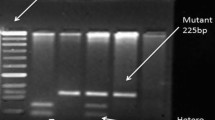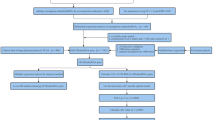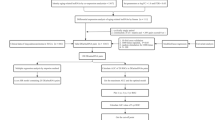Abstract
Platinum-based chemotherapy is the standard first-line treatment for most lung cancer patients. However, the toxicity induced by platinum-based chemotherapy greatly impedes its clinical use. Previous studies showed that long non-coding RNAs (lncRNAs) with over 200 nucleotides in length affect drug response and toxicity. In the present study, we investigated the association of well-characterized lung cancer lncRNA polymorphisms with platinum-based chemotherapy toxicity in Chinese patients with lung cancer. A total of 467 lung cancer patients treated with platinum-based chemotherapy for at least two cycles were recruited. We primarily focused on gastrointestinal and hematological toxicities. A total of 14 potentially functional polymorphisms within 8 lncRNAs (HOTTIP, HOTAIT, H19, ANRIL, CCAT2, MALAT1, MEG3, and POLR2E) were genotyped. Unconditional logistical regression analysis was conducted to assess the associations. Gene-gene and gene-environment interactions were identified using the software generalized multifactor dimensionality reduction (GMDR). ANRIL rs1333049 was associated with severe overall toxicity in an additive model (adjusted OR=0.723, 95% CI=0.541–0.965, P=0.028). ANRIL rs1333049 was also associated with severe gastrointestinal toxicity in both the additive (adjusted OR=0.690, 95% CI=0.489–0.974, P=0.035) and dominant (adjusted OR=0.558, 95% CI=0.335–0.931, P=0.025) models. MEG3 rs116907618 was associated with severe gastrointestinal toxicity in an additive model (adjusted OR=1.717, 95% CI=1.007–2.927, P=0.047). GMDR identified the three-factor interaction model of POLR2E rs3787016-HOTTIP rs3807598-chemotherapy regimen as the best predictive model for hematological toxicity. In conclusion, ANRIL and MEG3 genetic polymorphisms are associated with severe platinum toxicity and could be considered as biomarkers for pretreatment evaluation in Chinese patients with lung cancer.
Similar content being viewed by others
Log in or create a free account to read this content
Gain free access to this article, as well as selected content from this journal and more on nature.com
or
References
Torre LA, Bray F, Siegel RL, Ferlay J, Lortet-Tieulent J, Jemal A . Global cancer statistics, 2012. CA Cancer J Clin 2015; 65: 87–108.
Siegel R, Ma J, Zou Z, Jemal A . Cancer statistics, 2014. CA Cancer J Clin 2014; 64: 9–29.
Silvestri G, Pritchard R, Welch HG . Preferences for chemotherapy in patients with advanced non-small cell lung cancer: descriptive study based on scripted interviews. BMJ 1998; 317: 771–5.
Rabik CA, Dolan ME . Molecular mechanisms of resistance and toxicity associated with platinating agents. Cancer Treat Rev 2007; 33: 9–23.
Tani H, Torimura M . Development of cytotoxicity-sensitive human cells using overexpression of long non-coding RNAs. J Biosci Bioeng 2015; 119: 604–8.
Liu Y, Xu N, Liu B, Huang Y, Zeng H, Yang Z, et al. Long noncoding RNA RP11-838N2.4 enhances the cytotoxic effects of temozolomide by inhibiting the functions of miR-10a in glioblastoma cell lines. Oncotarget 2016; 7: 43835–51.
Bai W, Yang J, Yang G, Niu P, Tian L, Gao A . Long non-coding RNA NR_045623 and NR_028291 involved in benzene hematotoxicity in occupationally benzene-exposed workers. Exp Mol Pathol 2014; 96: 354–60.
Xu X, Ren H, Zhou B, Zhao Y, Yuan R, Ma R, et al. Prediction of copper transport protein 1 (CTR1) genotype on severe cisplatin induced toxicity in non-small cell lung cancer (NSCLC) patients. Lung Cancer 2012; 77: 438–42.
Hindorff LA, Sethupathy P, Junkins HA, Ramos EM, Mehta JP, Collins FS, et al. Potential etiologic and functional implications of genome-wide association loci for human diseases and traits. Proc Natl Acad Sci U S A 2009; 106: 9362–7.
Gong WJ, Yin JY, Li XP, Fang C, Xiao D, Zhang W, et al. Association of well-characterized lung cancer lncRNA polymorphisms with lung cancer susceptibility and platinum-based chemotherapy response. Tumour Biol 2016; 37: 8349–58.
Trotti A, Colevas AD, Setser A, Rusch V, Jaques D, Budach V, et al. CTCAE v3.0: development of a comprehensive grading system for the adverse effects of cancer treatment. Semin Radiat Oncol 2003; 13: 176–81.
Lou XY, Chen GB, Yan L, Ma JZ, Zhu J, Elston RC, et al. A generalized combinatorial approach for detecting gene-by-gene and gene-by-environment interactions with application to nicotine dependence. Am J Hum Genet 2007; 80: 1125–37.
Nie FQ, Sun M, Yang JS, Xie M, Xu TP, Xia R, et al. Long Noncoding RNA ANRIL promotes non–small cell lung cancer cell proliferation and inhibits apoptosis by silencing KLF2 and P21 expression. Mol Cancer Ther 2015; 14: 268–77.
Lin L, Gu ZT, Chen WH, Cao KJ . Increased expression of the long non-coding RNA ANRIL promotes lung cancer cell metastasis and correlates with poor prognosis. Diagn Pathol 2015; 10: 14.
Yap KL, Li S, Muñoz-Cabello AM, Raguz S, Zeng L, Mujtaba S, et al. Molecular interplay of the noncoding RNA ANRIL and methylated histone H3 lysine 27 by polycomb CBX7 in transcriptional silencing of INK4a. Mol Cell 2010; 38: 662–74.
Yuan XW, Zhu XF, Huang XF, Sheng PY, He AS, Yang ZB, et al. P14ARF sensitizes human osteosarcoma cells to cisplatin-induced apoptosis in a p53-independent manner. Cancer Biol Ther 2007; 6: 1074–80.
Al-Mohanna MA, Manogaran PS, Al-Mukhalafi Z, Al-Hussein KA, Aboussekhra A . The tumor suppressor p16INK4a gene is a regulator of apoptosis induced by ultraviolet light and cisplatin. Oncogene 2004; 23: 201–12.
Cunnington MS, Santibanez Koref M, Mayosi BM, Burn J, Keavney B . Chromosome 9p21 SNPs associated with multiple disease phenotypes correlate with ANRIL expression. PLoS Genet 2010; 6: e1000899.
Gabory A, Jammes H, Dandolo L . The H19 locus: Role of an imprinted non-coding RNA in growth and development. Bioessays 2010; 32: 473–80.
Chen B, Yu M, Chang Q, Lu Y, Thakur C, Ma D, et al. Mdig de-represses H19 large intergenic non-coding RNA (lincRNA) by down-regulating H3K9me3 and heterochromatin. Oncotarget 2013; 4: 1427–37.
Liu F, Killian J, Yang M, Walker R, Hong J, Zhang M, et al. Epigenomic alterations and gene expression profiles in respiratory epithelia exposed to cigarette smoke condensate. Oncogene 2010; 29: 3650–64.
Tsang W, Kwok T . Riboregulator H19 induction of MDR1-associated drug resistance in human hepatocellular carcinoma cells. Oncogene 2007; 26: 4877–81.
Chen S, Huo X, Lin Y, Ban H, Lin Y, Li W, et al. Association of MDR1 and ERCC1 polymorphisms with response and toxicity to cisplatin-based chemotherapy in non-small-cell lung cancer patients. Int J Hyg Environ Health 2010; 213: 140–5.
Yang C, Tang R, Ma X, Wang Y, Luo D, Xu Z, et al. Tag SNPs in long non-coding RNA H19 contribute to susceptibility to gastric cancer in the Chinese Han population. Oncotarget 2015; 6: 15311–20.
Nakagawa T, Endo H, Yokoyama M, Abe J, Tamai K, Tanaka N, et al. Large noncoding RNA HOTAIR enhances aggressive biological behavior and is associated with short disease-free survival in human non-small cell lung cancer. Biochem Biophys Res Commun 2013; 436: 319–24.
Liu Z, Sun M, Lu K, Liu J, Zhang M, Wu W, et al. The long noncoding RNA HOTAIR contributes to cisplatin resistance of human lung adenocarcinoma cells via downregualtion of p21WAF1/CIP1 expression. PLoS One 2013; 8: e77293.
Xue Y, Gu D, Ma G, Zhu L, Hua Q, Chu H, et al. Genetic variants in lncRNA HOTAIR are associated with risk of colorectal cancer. Mutagenesis 2015; 30: 303–10.
Guo W, Dong Z, Bai Y, Guo Y, Shen S, Kuang G, et al. Associations between polymorphisms of HOTAIR and risk of gastric cardia adenocarcinoma in a population of north China. Tumor Biol 2015; 36: 2845–54.
Lu KH, Li W, Liu XH, Sun M, Zhang ML, Wu WQ, et al. Long non-coding RNA MEG3 inhibits NSCLC cells proliferation and induces apoptosis by affecting p53 expression. BMC Cancer 2013; 13: 461.
Liu J, Wan L, Lu K, Sun M, Pan X, Zhang P, et al. The long noncoding RNA MEG3 contributes to cisplatin resistance of human lung adenocarcinoma. PLoS One 2015; 10: e0114586.
Ji P, Diederichs S, Wang W, Böing S, Metzger R, Schneider PM, et al. MALAT-1, a novel noncoding RNA, and thymosin β4 predict metastasis and survival in early-stage non-small cell lung cancer. Oncogene 2003; 22: 8031–41.
Lai MC, Yang Z, Zhou L, Zhu QQ, Xie HY, Zhang F, et al. Long non-coding RNA MALAT-1 overexpression predicts tumor recurrence of hepatocellular carcinoma after liver transplantation. Med Oncol 2012; 29: 1810–6.
Wang KC, Chang HY . Molecular mechanisms of long noncoding RNAs. Mol Cell 2011; 43: 904–14.
Nikolić ZZ, Brajušković GN . Pavićević DLj, Kojić AS, Vukotić VD, Tomović SM, et al. Assessment of possible association between rs3787016 and prostate cancer risk in Serbian population. Int J Clin Exp Med 2013; 6: 57–66.
Benjamini Y, Yekutieli D . The control of the false discovery rate in multiple testing under dependency. Ann Statist 2001; 29: 1165–88.
Acknowledgements
The authors would like to thank all of the patients who participated in the study. This work was supported by the National Key Research and Development Plan (SQ2016YFSF110100 and 2016YFC0905000), National Natural Science Foundation of China (81373490, 81573508, and 81573463), Hunan Provincial Science and Technology Plan of China (2015JC3025), and Open Foundation of Innovative Platform in University of Hunan Province of China (421530004).
Author information
Authors and Affiliations
Corresponding author
Additional information
Supplementary information is available at the website of Acta Pharmacologica Sinica.
Supplementary information
Supplementary Table S1
Clinical characteristics of patients with Gastrointestinal toxicity (DOC 59 kb)
Supplementary Table S2
Clinical characteristics of patients with hematologic toxicity. (DOC 61 kb)
Supplementary Table S3
Basic information of SNPs in lncRNAs. (DOC 37 kb)
Supplementary Table S4
The association of gene-gene interaction and toxicity induced by platinum-based chemotherapy. (DOC 25 kb)
PowerPoint slides
Rights and permissions
About this article
Cite this article
Gong, Wj., Peng, Jb., Yin, Jy. et al. Association between well-characterized lung cancer lncRNA polymorphisms and platinum-based chemotherapy toxicity in Chinese patients with lung cancer. Acta Pharmacol Sin 38, 581–590 (2017). https://doi.org/10.1038/aps.2016.164
Received:
Accepted:
Published:
Issue date:
DOI: https://doi.org/10.1038/aps.2016.164
Keywords
This article is cited by
-
CCAT2 role in gastrointestinal cancer progression and metastasis: a novel target for therapeutic strategies
Clinical and Experimental Medicine (2025)
-
Six polymorphisms in the lncRNA H19 gene and the risk of cancer: a systematic review and meta-analysis
BMC Cancer (2023)
-
Circulating noncoding RNAs: promising biomarkers in liquid biopsy for the diagnosis, prognosis, and therapy of NSCLC
Discover Oncology (2023)
-
LncRNA in tumorigenesis of non-small-cell lung cancer: From bench to bedside
Cell Death Discovery (2022)
-
Nitrate increases cisplatin chemosensitivity of oral squamous cell carcinoma via REDD1/AKT signaling pathway
Science China Life Sciences (2021)



